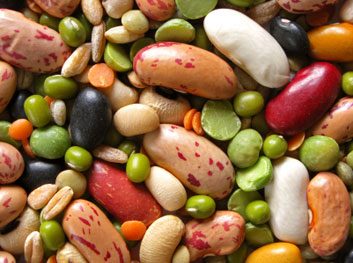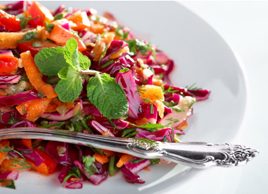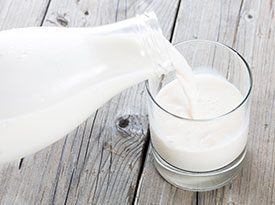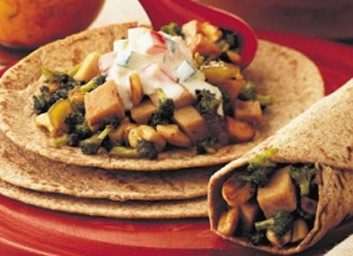
Give your pantry a makeover
We all know what it’s like to get in the door after a busy day and have no clue what to eat. But if you stock a well-organized pantry, you’ll find that throwing meals together is much easier when you have the right ingredients at hand. ?
We’ve taken some creative licence with the word “pantry” to include your fridge and freezer. As to what you need to buy? “I break it down into categories,” says Lisa Tsakos, a registered holistic nutritionist and co-author of Unjunk Your Junk Food. Tsakos divides her pantry into the following items:
• Grains (quinoa, millet, brown rice)
• Flours (brown rice, whole grain)
• Pasta (brown rice, kamut, spelt)
• Dried beans
• Nuts and seeds or legumes
• Non-dairy milk
• Dried fruits
• Herbs and spices
• A selection of sulfite-free vinegars
With these categories in mind, here are some ideas that will provide you with multiple options for healthy meals-and hopefully make you pause before reaching for the phone to order takeout.

Stock up on beans
Kidney, black, pinto, navy-all of these beans can be used for quick and healthy weeknight meals. “Beans are the best form of fibre in our diet when cooked properly,” says Tsakos. Canned beans are great for emergencies. Watch for sales and be sure to rinse them really well. Buying dried beans in bulk is even more inexpensive. “Because preparing beans is a labour of love, I do it all at once and freeze them,” says Tsakos, who will set up four pots on the stove at a time and boil different kinds of beans, 60 to 70 percent of the way through. She then drains them well and puts them in containers to freeze. A quick boil after thawing will make them ready for meals.
To store: Dried beans will last for several months on a cool, dry shelf.
Recipe to try: Tuscan Mixed Bean Soup

Boil your own soup broth
A simple vegetable stock can add flavour to rice and quinoa, baked chicken and, of course, soup. By making it yourself, you are in charge of the flavour and sodium content.
For a standard stock, chop up a few potatoes, carrots, celery, onion, and season with herbs and spices. Bring everything to a boil in a large pot filled with 10 to 15 cups of water and then let it simmer on low heat. Tsakos will save leftover vegetables, like the end of a head of lettuce or the stem of a green pepper, and store it in the freezer until she has enough to throw in a pot. It’s a way to recycle your vegetables and it still has lots of nutritional value, she says.
To store: Measure your broth into one- or two-cup containers, so you always know how much you’re grabbing from the freezer. Use ice cube trays to store for smaller meals.
Recipe to try: Tuscan White Bean Soup

Mix your own salad dressing
While the dressing can often be the most exciting thing about a salad, the fat and calories can add up. An easy standby is to blend organic olive oil, balsamic vinegar and maple syrup. You could also experiment with red wine or apple cider vinegars. “Keep in mind that a tablespoon of oil has about 13 grams of fat,” says Tsakos. For a creamy Caesar dressing substitute, Tsakos will mix a little lemon juice and dill or parsley with plain, organic yogurt.
To store: Refrigerate small batches. Olive oil will separate and solidify on the surface, so bring your dressing to room temperature and stir well before using.
Recipe to try: Spinach Salad with Berry Mint Dressing

Blend your own pesto
Pesto is a great way to season a quick pasta dish, soup or fish and can be used as a tomato sauce substitute on pizza. “Whatever green you have is rich in magnesium, one of the most important minerals to help deal with stress,” says Tsakos. The garlic is anti-inflammatory and good for your immune system.
To make a fresh pesto, take two cups of fresh basil or parsley, add a clove or two of garlic, 1/2 to 1/3 cup of pine nuts and 1/2 to 1/3 cup of olive oil. Season with salt and pepper, and blend in a food processor. For a dairy-free alternative to Parmesan, try sprinkling your pesto with nutritional yeast. “It is packed with B-vitamins and lasts forever,” says Tsakos.
To store: Pesto will keep for a few days in the refrigerator. Make a big batch (without Parmesan) and seal it well in an ice cube tray. Once frozen, pop out the pesto cubes and store in an airtight freezer bag, then simply grab a cube or two from the bag when needed.
Recipe to try: Pesto Pork Chops

Season with herbs and spices
Sometimes all you need to jazz up a meal is a dash of spice or freshly cut herbs. “During different seasons, I’ll season differently,” says Tsakos, who recommends rubbing fresh herbs between your palms to release the flavour. For a butternut squash and carrot soup, she’ll add cinnamon and nutmeg in fall, and rosemary and thyme in the spring.
To store: Fresh herbs only keep for a few days, but spices will last up to two months in a sealed container.
Recipe to try: Rosemary Marinated Olives

Experiment with dairy-free milk
For those who want to experiment with healthy dairy alternatives, especially families with sensitivities, there is a variety of dairy-free milk that you can store in the cupboard. Tsakos keeps an eye on sales and then stocks up on almond, rice, oat, soy and hemp milk. These can all be used for baking, soup bases, on cereal and in smoothies. Tsakos likes soy or almond milk for its richer consistency than skim or 1% milk. She’ll add it to pureed broccoli or butternut squash with carrots for a creamy soup.
To store: The milks listed above come in aseptic containers that you can store in the cupboard for months (just be sure to check the expiry dates).
Recipe to try: Dairy-Free Fig and Raspberry Rice Pudding

Mix quick meals in wraps and pitas
For quick, convenient meals, keep a bag or two of wraps and pitas in the freezer. Place them in the oven on low for a couple of minutes to thaw, then throw on the toppings. They’re very versatile and as a bonus, they’re lower in yeast, says Tsakos, who will use them for quick pizzas and tuna melts. Look for 100 percent whole wheat, with water and salt as the only other ingredients. You can also find wraps made from spelt or sprouted grain.
To store: Pitas and wraps will keep for a couple of months in the freezer. If refrigerating, pay close attention to the expiry date on the package.
Recipe to try: Indian Chicken and Broccoli Wrap
Related:
• 14 healthy 30-minute meals
• 8 budget superfoods, plus recipes to try
• 10 foods you should eat every day
